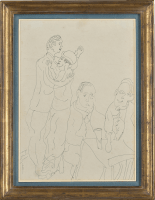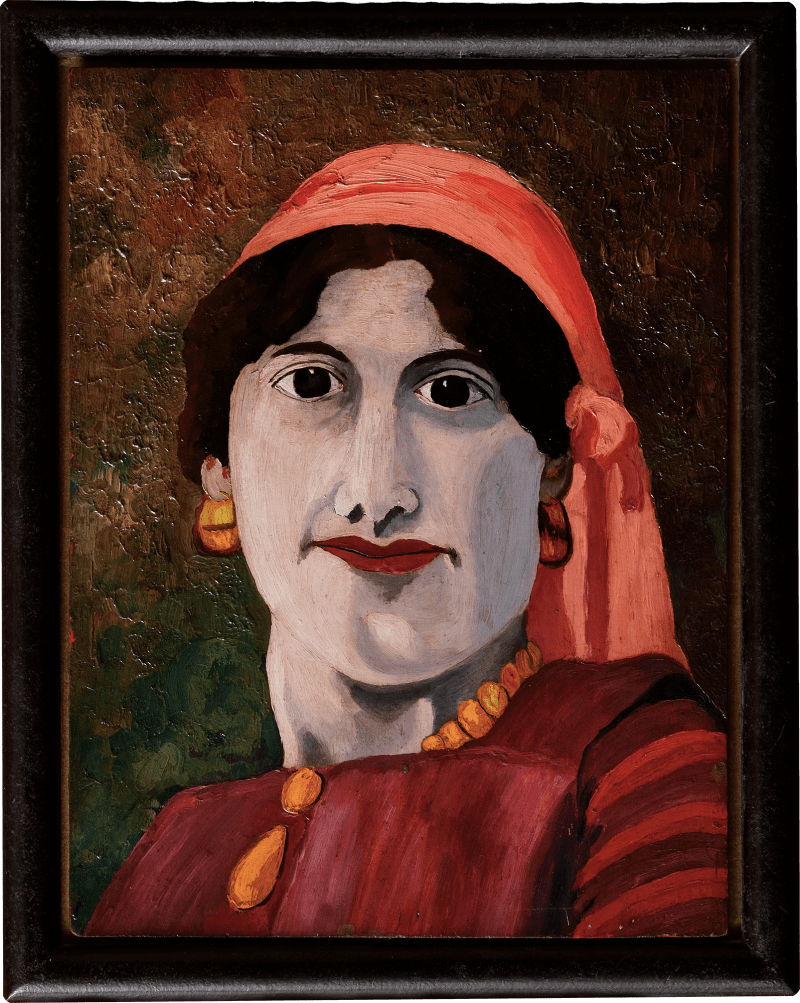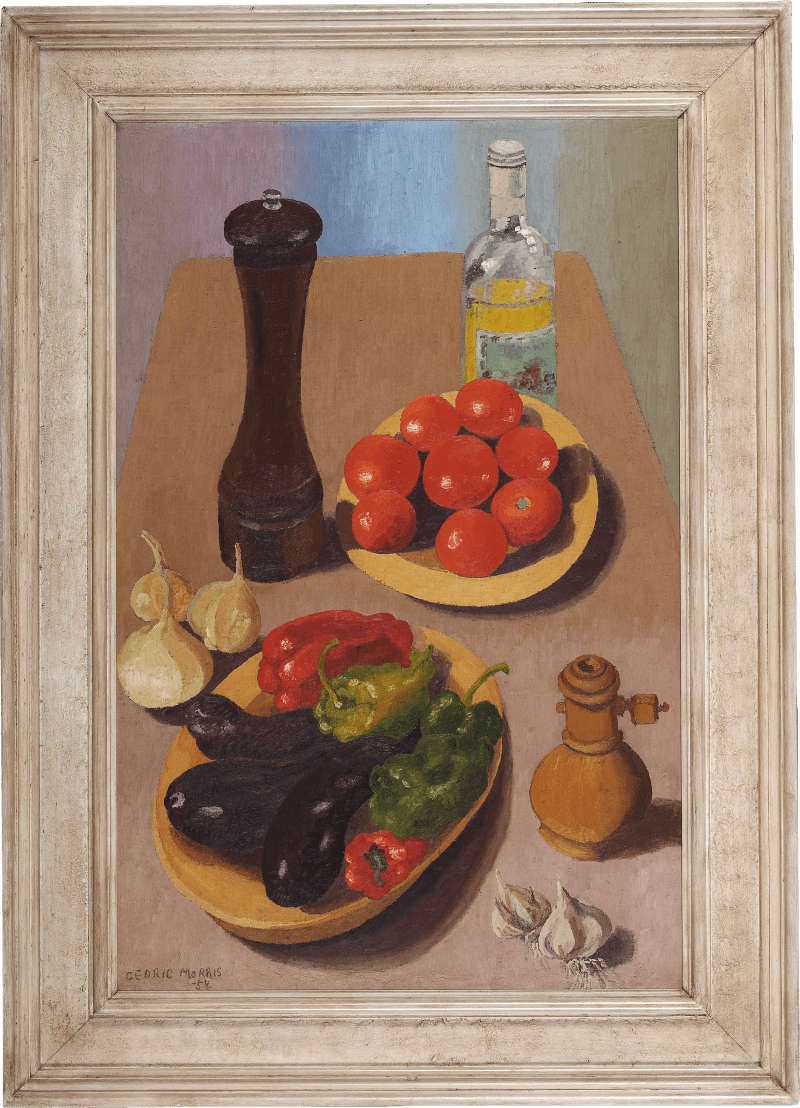Throughout Cedric Morris’ life, he and lifelong partner Arthur Lett-Haines (known as ‘Lett’) travelled prolifically and surrounded themselves amongst the characters that would soon become the subject of many of Morris’ works. In 1919 Morris and Lett had moved to Cornwall and were amongst some of the most prominent of the Newlyn artists. They became known for their ‘high-spirited and unconventional behaviour’, being seen as the bohemian element amongst the more traditional group. Here they held lively parties and were described as having 'a dancing gait, like gazelles’.[1] Though they frequently returned to Cornwall, in 1920 they took their free spirit to France where they moved within the artistic, literary, theatrical, and social circles of 1920s Paris. As noted in Lett’s Chronology Book of the people they knew in Paris between the years 1921 and 1926, they mixed with the likes of Marcel Duchamp and Man Ray and were often cited in several gossip columns in the English-language newspapers in...
Throughout Cedric Morris’ life, he and lifelong partner Arthur Lett-Haines (known as ‘Lett’) travelled prolifically and surrounded themselves amongst the characters that would soon become the subject of many of Morris’ works. In 1919 Morris and Lett had moved to Cornwall and were amongst some of the most prominent of the Newlyn artists. They became known for their ‘high-spirited and unconventional behaviour’, being seen as the bohemian element amongst the more traditional group. Here they held lively parties and were described as having 'a dancing gait, like gazelles’.[1] Though they frequently returned to Cornwall, in 1920 they took their free spirit to France where they moved within the artistic, literary, theatrical, and social circles of 1920s Paris. As noted in Lett’s Chronology Book of the people they knew in Paris between the years 1921 and 1926, they mixed with the likes of Marcel Duchamp and Man Ray and were often cited in several gossip columns in the English-language newspapers in Paris.[2]
Parisian bars and cafes became a common subject in Morris’ early works and can be seen as a direct insight into his working process and life during this period. Morris is often noted as a great observer and ‘watcher’ of people, having known to ‘meander about slowly, watching things move…a twinkle lurking in his eye’.[3] He would observe to the degree of getting lost within the person observed in order to capture their idiosyncrasies and the nature of a certain cultural milieu.[4] Morris’ pen drawing is a clear example of his ability to set out the appearance of the person or scene before him with such directness and immediacy that the viewer is struck with an overwhelming sense of presence. As Glyn Morgan noted in 1994 in a joint exhibition on the two artists, ‘Cedric always insisted that he could not draw, which was of course not true as anyone who has seen his silverpoint drawings knows. He was certainly not a conventional draughtsman…so any influence he had on me was one of attitude rather than technique’.[5] This attitude, as is so prevalent in Two Dancers, reveals Morris’ contention that ‘there must always be a great understanding between painter and the thing painted, otherwise there can be no conviction and no truth…This might be called ‘vision’ and reality, as opposed to realism. Reality is knowledge and realism is only the appearance of knowledge…’.[6] Although Morris is referring to his painted works here, the process of documenting the culture of 1920s Paris would likely, if not certainly, be done in the same manner. The knowledge gained from his observations is reduced into a few telling lines and one is transported to the noise and chatter of the Parisian bar that Morris visited.
This fine drawing provides insight into a time in Morris's early years that would ultimately be left for the development of his renowned oil paintings. Such drawings demonstrate Morris’ dedication to the observation of human character and the workings that would inform his later style. It is therefore significant that Morris would not return to drawing in his remaining fifty years as an artist and even reject this skill in his curriculum at the East Anglian School of Painting and Drawing that he and Lett would come to establish. In 1974 he told Lord Aberdeen that for many years he was unable to bring himself to work on paper, but rather opted for a thick paint texture. Millie Hayes, a student at the EASPD, recalls Morris advising students not to draw with paint but rather to ‘bounce’ with it across the canvas.[7]
[1] Morphet, R. (1984) Cedric Morris. London: Tate Gallery, p. 21.
[2] Morphet, R. (1984) Cedric Morris. London: Tate Gallery, p. 23.
[3] Tyner, C. (1983) Letter to Richard Morphet, 19 August 1983 (Mrs. Chloe Tyner was the daughter of Madame Elspeth Champcommunal with whom Cedric stayed in Vaucluse at Giverny).
[4] Blond Fine Art Ltd. (1979) Sir Cedric Morris: A Ninetieth Year Tribute. London: Blond Fine Art.
[5] Morgan, G. (1994) Master and Pupil: Sir Cedric Morris and Glyn Morgan. Colchester: Chappel Galleries Fine Art.
[6] Earp, T.W. (1928) ‘Cedric Morris’, The Studio. Vol. 96n No. 427, pp. 220-2.
[7] Morphet, R. (1984) Cedric Morris. London: Tate Gallery, p. 90.











